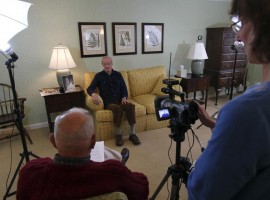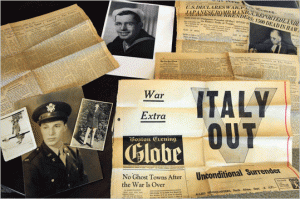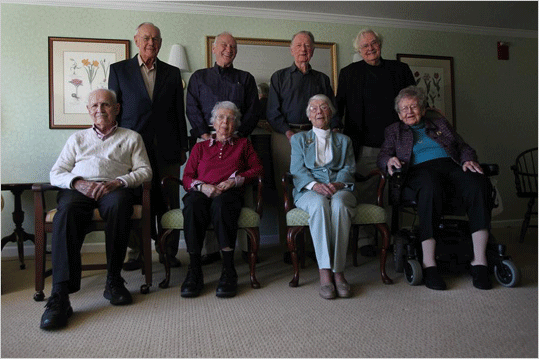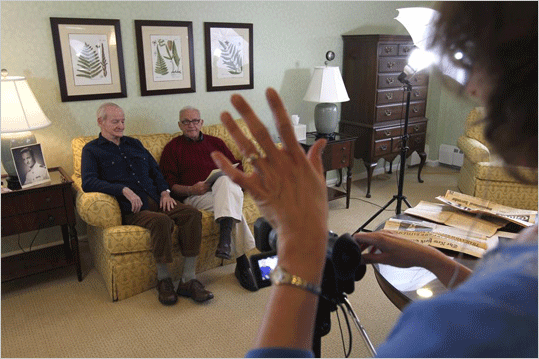Retelling Tales, for the Record
November 11, 2012

World War II vet Ned Thomas shares his memories with interviewer Tom Larkin and videographer Leslie Wittman in Bedford.
The Boston Globe
Retelling tales, for the record
By Nancy Shohet West
GLOBE CORRESPONDENT
When friends gather over a meal at Carleton-Willard Village, telling “war stories” isn’t just a figure of speech. A look around the table reflects a range of roles during World War II. One repaired battleships. Another flew for the Royal Air Force. Here sits a former Red Cross nurse; there a younger sister who saw her elder brother for the last time as he departed in uniform. The residents of this Bedford continuing care community, now in their 80s and 90s, were young men and women in the days of the war — yet memories of their experiences are as sharp as they were seven decades ago. As Allan Sloan recalls, he recognized as soon as he and his wife moved to Carleton-Willard that there was something distinctive about their new neighbors. “As we began meeting people, it quickly became apparent to me that we were joining a generation of people who were college students and young adults during World War II,’’ said Sloan. “At dinner, we’d start sharing little snippets of conversation, but no one had a chance to envelop the whole story. Eventually, some of us started talking amongst ourselves, saying ‘Shouldn’t these stories be preserved? Shouldn’t we be keeping some record of what we had all lived through?’??” The Sloans, along with Esther Braun, Mary Welch, and five other interested residents formed a committee that set as its mission to videotape an oral history of World War II. The first step was to send out a questionnaire asking members of the Carleton-Willard community about their World War II experiences. Sixty people responded. What was particularly interesting about the response, Sloan said, was the range of roles that the men and women around him had filled. Yes, there were men who had seen active duty. But there were also women who worked in governmental offices decoding secret messages. There were brides left at home to maintain the household while their new husbands headed overseas. One resident had been on the Red Cross Recreation Committee, offering refreshments and amusement to members of the armed forces. One was stationed on a repair ship in Scotland, providing maintenance for ships damaged by submarines or bombs.

Clippings assembled for the Carleton-Willard Village oral history project.
Mary Welch was a college student traveling through Europe in the summer of 1939, and realized only in retrospect that the seeds of war had been sprouting all around her. “We had been all through Norway, Sweden, and Denmark that summer, and had no premonition of anything being amiss until we ran into a German student in Lund who did a ‘Heil Hitler’ salute to us, thinking we were German,” Welch recalled. “Later, I learned that all that winter, Scandinavia took the brunt of shelling. Some of the towns we’d just traveled through were reduced to ashes.”
The village committee decided to start conducting formal interviews to capture people’s experiences, and began looking for some technical support to help turn the results into a video that others could see. “We knew how to do interviews,’’ Braun said, “but who would film and edit them?”
They spoke with Stephanie Smith, director of public relations for Carleton-Willard Village, who reached out to Bedford Historical Society president Jan van Steenwijk.
“Coincidentally enough, he said the Bedford Historical Society just happens to have a hole in its archives around the World War II era, and that he would definitely be interested in helping us out,” Smith said. “He also had access to the video equipment at our local TV station, and he knew how to do videography.”
“It’s an absolutely wonderful project,” said van Steenwijk. “The stories are so diverse. From the housewife at home while the husband went abroad to nurses in Europe helping save wounded soldiers to bombardiers on flying missions. . . . I’m very pleased that now it’s preserved on DVD and can be shown on local TV.”
Not all of the voices represent American involvement in the war. One of the first interview subjects was German-born Erasmus Belden, who was barely 20 and living in Berlin when war broke out in his homeland. He recalls helping a man named Eberhard Helmrich, a Schindler-type figure who smuggled Jews to safety, saving them from concentration camps. Another subject with a gripping story to tell was Englishman Derek Till, a member of Britain’s Royal Air Force.
Eventually, the project became too large for van Steenwijk to manage as a volunteer; in stepped professional videographer Leslie Wittman, who has contributed immeasurably to the project, according to the committee members, by adding artistic elements such as maps and historical photos to supplement the interview footage.
But Wittman, a generation younger than the project participants, said that she reaped an unanticipated reward through her participation in the effort.
“My parents are Jews from Hungary. They were children during the war. Their parents and families were killed. World War II was not something we talked about in our family; it was too painful for them. And it was never something I wanted to get involved in before.
“But I’m so happy I took on this project, because through meeting these people and hearing their stories, I’ve become so thankful and grateful for what people from this country have done. They saved what was left of my family and millions of other people,” Wittman said.
The project remains a work in progress. The committee has started offering monthly screenings in the Carleton-Willard Village’s auditorium, one interview at a time; after the first month or two, they regularly attracted a full house, and now the footage airs weekly on Bedford TV, the town’s community-access station.
A special guest earlier this fall provided a shot of adrenaline; thanks to a personal connection with a Carleton-Willard resident, the filmmaker known for his PBS documentaries stopped by to talk with the group. “Ken Burns emphasized to us that we were doing a service by putting out these stories,” said committee member Don Manion. “He helped us to see that there are now generations of Americans with no conception of World War II — not so much in terms of the historical circumstances, but in terms of the attitudes of the American populace.
“Without stories like ours, people don’t understand the extent to which nearly every American jumped into the harness and pulled in the same direction. We were not well-prepared to fight this war. But through spirit and tremendous effort, we were able to assist the countries of Europe and later, after the Pearl Harbor attack, to engage on our own behalf,’’ Manion said.
“We just want people now to realize that they have a darn good life as a result of having won this war,” said Sloan. “That’s the thing some younger people sort of forget. They’ve had a pretty easy time because they didn’t have to put up with a fascist government telling them what to do. And that’s thanks to World War II.”
WWII video memories project in Bedford
At Carleton-Willard Village in Bedford, seniors are making their own oral history of WWII.
The WWII Memories Project Committee is pictured. Back row- Don Manion, Tom Larkin, Derek Till, Allan Sloan. Front row- Erasmus Belden, Esther Braun, Mary Hastings, Mary Welch.

Luis Fernandez-Herlihy
Fernandez-Herlihy was a teenager who lived in the Netherlands when World War II broke out. His father was the Mexican Consul in Rotterdam.
Stuart Grover
Grover was on a mine sweeper in the Mediterranean during the War. Their assignment was to clear a harbor of mines ahead of the arrival of Allied ships.
Anne Larkin
Larkin was born the youngest of 6 children to parents who were immigrants from Italy. Her oldest brother Anthony joined the US Army Air Force in 1942 and was killed on his last flight (a mission he volunteered for) in 1945.
Memorabilia from the WWII Memories Project being filmed with seniors at Carleton-Willard Village in Bedford.

Caleb Warner
With specialized training in naval architecture and technology, during WWII Warner was assigned to a repair ship and stationed in Great Britain. His ship was across the Channel from Normandy Beach on D-Day and under direct threat from the enemy.
Ward Chamberlin
Chamberlin describes the WWII battlefield conditions from the perspective of an ambulance driver. He observed first hand the 1942 battles against German Field Marshall Erwin Rommel in In N. Africa. After the victory in N. Africa he was transferred to Italy where he received a battlefield commission when his commander was killed.
Wittman records interviewer Tom Larkin (center) interviewing WWII vet Ned Thomas in October.

Daniele Stewart
Stewart was a teenager in Alsace where she lived with her family. During WWII it was taken over by the Germans and she tells of her life in Paris where her family moved to escape.
Richard Smith
As a naval pharmacist mate (medic) during WWII, Smith was on the initial and subsequent landings in Normandy carrying troops, tanks and trucks to the beach and bringing wounded back to England.
John Mannarino
Mannarino was already a practicing lawyer when he enlisted in the army as an interpreter. Because of his Italian background, he was fluent in Italian. He was assigned to a colonel in the Italian campaign and worked as interpreter his interpreter.
Eleanor Voorhies
Voorhies was a nurse in the Yale University Hospital team which cared for the wounded from the islands in the Pacific from 1943 to the end of WWII.